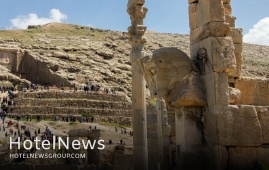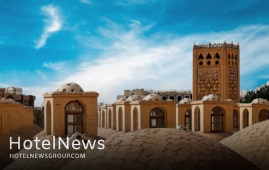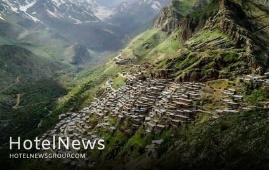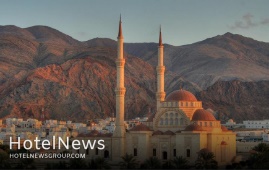
Authorities of Persepolis have launched an unmanned aerial vehicle (UAV) documentation project to help study and analyze the neighboring lands and properties, which encircle the UNESCO World Heritage site in southern Iran. “A documentation project has been commenced on the closest boundaries of Persepolis to gather needed information to monitor possible changes and interventions in this area,” said Hamid Fadaei, the director of the World Heritage site. The first purpose of this documentary is to prepare a cadastral map of agricultural lands in the first-grade boundaries of Persepolis, and the second purpose is to record the current status of historical monuments, including historical sites and hills that are dotted in that area, Fadaei explained. “In that regard, we operate close-range photogrammetry and UAV in the documentation of architecture monuments…..And the project is expected to become to an end by the yearend (March 20, 2022),” the official noted. Persepolis, also known as Takht-e Jamshid, whose magnificent ruins rest at the foot of Kuh-e Rahmat (Mountain of Mercy) is situated 60 kilometers northeast of the city of Shiraz in Fars province. It was the seat of the government of the Achaemenid Empire, though it was designed primarily to be a showplace and spectacular center for the receptions and festivals of the kings and their empire. Persepolis ranks among the archaeological sites which have no equivalent, considering its unique architecture, urban planning, construction technology, and art. This 13-ha ensemble of majestic approaches, monumental stairways, throne rooms (Apadana), reception rooms, and dependencies is classified among the world’s greatest archaeological sites. The city’s immense terrace was begun about 518 BC by Darius the Great, the Achaemenid Empire’s king. On this terrace, successive kings erected a series of architecturally stunning palatial buildings, among them the massive Apadana palace and the Throne Hall (“Hundred-Column Hall”). According to Britannica, the stone was cut with the utmost precision into blocks of great size, which were laid without mortar; many of them are still in place. Especially striking are the huge columns, 13 of which still stand in the audience hall of Darius I (the Great; reigned 522–486 BC), known as the Apadana, the name given to a similar hall built by Darius at Susa. There are two more columns still standing in the entrance hall of the Gate of Xerxes, and a third has been assembled there from its broken pieces. Narratives say that Persepolis was burnt by Alexander the Great in 330 BC apparently as revenge to the Persians because it seems the Persian King Xerxes had burnt the Greek City of Athens around 150 years earlier.
Create: Dec 29, 2021 Edit: Dec 29, 2021 Regional News
New legal boundaries have been defined for five historical properties, which are scattered across Yazd province. The Ministry of Cultural Heritage, Tourism, and Handicrafts has announced the exact legal boundaries of the properties in separate letters to the governor-general of the central province, IRIB reported on Tuesday. In addition to protecting historical sites, the demarcation projects are aimed to prevent further destruction and damage. Esfahanian Garden House, Eqbal Factory, Vazir Castle, Ezzatabad Castle, and Ezzatabad Kushk (small garden pavilion) are those demarcated recently. In July 2017, the historical structure of the city of Yazd was named a UNESCO World Heritage. Wedged between the northern Dasht-e Kavir and the southern Dasht-e Lut on a flat plain, the oasis city enjoys a very harmonious public-religious architecture that dates from different eras. Yazd is usually referred to as a delightful place to stay, or a “don't miss” destination by almost all of its visitors. The city is full of mudbrick houses that are equipped with innovative badgirs (wind catchers), atmospheric alleyways, and many Islamic and Iranian monuments that shape its eye-catching city landscape. It is a living testimony to the intelligent use of limited available resources in the desert for survival. Water is brought to the city by the qanat system. Each district of the city is built on a qanat and has a communal center. The use of earth in buildings includes walls and roofs by the construction of vaults and domes. Houses are built with courtyards below ground level, serving underground areas. Wind-catchers, courtyards, and thick earthen walls create a pleasant microclimate. Partially covered alleyways together with streets, public squares and courtyards contribute to a pleasant urban quality. The city escaped the modernization trends that destroyed many traditional earthen cities.
Create: Dec 29, 2021 Edit: Dec 29, 2021 Regional News
AC Hotel St. Louis Central West End (215 York Ave, St. Louis, MO 63108), a seven-story 192-room hotel, is now open after a multi-million dollar, ground-up build by St. Louis’ Koplar Properties in partnership with Homebase Partners and Concord Hospitality Enterprises. Located in the Central West End neighborhood of St. Louis, Missouri, the hotel sits in the heart of the city’s upscale retail district and at the eastern edge of Forest Park. The 94,300 square-foot hotel features a state-of-the-art fitness center, small meeting and event space, and curated food and beverage program with inspiration from the hotel’s Spanish and European roots at the AC Kitchen and AC Lounge. The hotel is a new modern and sophisticated destination for culturally-minded travelers and locals alike. This is the first AC Hotel to enter the St. Louis market. Located in the upscale Central West End neighborhood, the hotel is surrounded by sidewalk cafes, smart Italian and Asian fusion restaurants, local coffee shops, chic boutiques and more. Directly across the street sits St. Louis’ award-winning Forest Park with expansive lakes, woods, a golf course and free museums and attractions including the St. Louis Zoo and Saint Louis Art Museum. Steps away are Barnes Jewish Medical Center, Shriners Hospital for Children, Washington University in St. Louis campus and St. Louis Children’s Hospital. AC Hotel St. Louis plans to immerse itself in St. Louis’ local culture, specifically in the arts, attractions and cuisine. HomeBase Partners’ Founder and Owner Andy Holloran said “Together with the Koplar family and Concord Hospitality, HomeBase Partners is excited to bring the AC St. Louis hotel to market in the heart of the vibrant Central West End. Within walking distance to so many restaurants, bars, coffee shops, Forest Park and the incredible medical campus anchored by Barnes Jewish, Children’s and Washington University, the AC Hotel is a much needed and welcome addition!” AC Hotel St. Louis Central West End blends St. Louis’ urban landscape with minimalist, sophisticated design, and features artwork from a local and nationally renowned artist. St. Louis born artist John O’ Hara was commissioned for a signature piece featured in the AC Kitchen and dining area of the hotel. O’Hara is a self-taught artist known for his abstract decorative art. His work is included in public and private collections around the world, including famed designer Michael Kors’ showrooms in Milan, Paris, London and New York. AC Hotel St. Louis Central West End seamlessly fits into the modern and upscale surroundings of the neighborhood, among its world-class art galleries, eye-catching public artwork and stunning turn-of-the-century homes. The sleek design creates a perfectly precise retreat for guests – both inside and out. On the exterior, a natural facade stands out with contemporary wood accents, ivy walls and greenery. Renowned design firm DLR Group worked on the hotel’s interior design, which hosts a blend of European-inspired motif and comfort, with modern decor, touches of natural wood and clean marble throughout the property. Upon entering the lobby, check-in-desks are flanked with a striking leather mosaic in sleek blacks, deep grey and metallic colors. The lobby also includes a welcoming communal space with a massive double-sided fireplace built into a floor-to-ceiling marble wall, which serves as a living room and informal business hub for guests to gather. The space is filled with modern furnishings and artwork, approaching every space with optimal comfort and utility which is intentionally designed to maximize space and minimize clutter. “The hotel design is purposeful, simplistic, and elegant while staying true to our unique aesthetic,” says General Manager Candice Woodring. “We’ve tailored our experiences for business travelers, leisure enthusiasts and locals to all find something at our property. Whether it’s a chic guest room after a long flight or Spanish tapas, signature cocktails and local craft beer with friends, we’ve got something for everyone – business or pleasure.” Furnished with 192 guestrooms, including 114 King sized beds, the design is classic modernism with clean lines, sharp angles, pops of marble and effortless European sophistication. Thoughtful design elements help guests unwind, including plush bedding, a spacious workspace, open closet concepts intuitively designed to create ease of access and visibility, as well as Korres bath amenities made with natural ingredients. Each guest room features precisely placed outlets for ultimate ease of access, a personal in-room coffee maker, temperature-controlled smart refrigerator and a safe. Rooms also feature the latest technologies including 55-inch smart televisions with app streaming and free high speed internet access throughout the property. In addition to in-room amenities, each guest floor features a state-of-the-art sustainability-focused hydration station equipped with glass carafes and purified water. Additional amenities include a state-of-the-art fitness center with Peloton, cardio equipment, free weights, and the AC Store, curated with locally-sourced snacks, sweets, beverages and other local products. Self-parking is available in the Argyle garage located directly across the street from the hotel. From breakfast in the AC Kitchen to cocktails and tapas in the AC Lounge, guests will enjoy flavors that are perfectly curated, poured and plated. The hotel’s European sensibility touches every aspect of the guest experience, including on-site dining. Breakfast at the AC Kitchen features gourmet selections such as fresh baked Delifrance buttered croissants, as well as Berkel sliced La Quercia prosciutto. The AC kitchen will also offer a full menu for guest’s and locals to enjoy with items such as Breakfast Cazuela, and Nutella & Orange Belgium Waffles. The AC Lounge provides guests with a warm and inviting atmosphere to enjoy a drink and a bite to eat with an ambient double-sided fireplace, ample cocktail and lounge seating and modern minimalist design. A harmonious gathering place with a touch of influence from its Spanish roots, the AC Lounge features curated European-inspired small plates after 5 p.m. as well as local libations and signature cocktails like its namesake AC-GT (a custom gin and tonic), served in a scientifically engineered cocktail glass with etchings that discreetly guide the perfect ratio of ingredients. AC Hotel St. Louis Central West End will also serve as an excellent destination for business meetings and social events. The hotel has flexible space to accommodate small business meetings, social functions, rehearsal dinners and celebrations. A dedicated conference room looks out to the bustling neighborhood and is equipped with complimentary high speed internet, 137” drop screen and projector, as well as a separate pre-function space. The hotel can provide a distinct area for private meetings and networking events. The property has also partnered with neighboring restaurant, Edera Italian Eatery, to host larger events with chef-curated menus from Edera’s Executive Chef, Andrew Simon.
Create: Dec 22, 2021 Edit: Dec 22, 2021 International News
Cambria Hotels, an upscale brand franchised by Choice Hotels International, Inc. (NYSE: CHH), continues to expand around the country with the official start of construction on the Cambria Hotel Niagara Falls. This is the fourth hotel to break ground in Q4 2021 and tops off a year of growth across the brand with new openings in popular cities like Louisville, Orlando, and Napa Valley, as well as an additional hotel in Nashville, and a fifth hotel in Washington, D.C. The 120-room hotel is expected to open in the Spring of 2023. Representatives from Choice Hotels, franchisee and developer Plati Niagara Inc., and local dignitaries attended the groundbreaking to commemorate the occasion. Located at 311 Rainbow Blvd. in downtown Niagara Falls, New York, the hotel will be two blocks from the world-famous Niagara Falls State Park, which welcomes over eight million visitors annually. Guests will be able to take advantage of popular tourist attractions like the Maid of the Mist boat tour or get closer to the Falls by descending into the Niagara Gorge at the Cave of the Winds. Future guests also will be able to visit the nearby Robert Moses Niagara Power Plant to see how the Falls serves as a hydroelectric power source. The Cambria Hotel Niagara Falls will feature upscale amenities and approachable indulgences that appeal to modern travelers, including: – Indoor and outdoor spaces for relaxation and productive work. – Locally inspired design and décor, reflecting the unique personality and rich history of the surrounding area. – Contemporary and sophisticated guest rooms, complete with design forward fixtures, abundant lighting and plush bedding. – Immersive, spa-style bathrooms with Bluetooth mirrors. – Bar and restaurant featuring freshly made food, local craft beers on tap, wine and specialty cocktails, as well as to-go options. – Multi-function meeting and event spaces. – State-of-the-art fitness center. The Cambria Hotel Niagara Falls will be developed by Plati Niagara Inc., which also owns a Quality Inn in Niagara Falls. There are currently almost 60 Cambria hotels open across the U.S. in popular cities such as Chicago, Los Angeles, New York, New Orleans, and Phoenix, with over 70 hotels in the pipeline.
Create: Dec 22, 2021 Edit: Dec 22, 2021 International News
MCR — the country’s 4th-largest hotel owner-operator — has acquired a portfolio of six premium-branded hotels in Texas and New Mexico, known as “smile states” for their location and fast-growing markets. Totaling 603 rooms, the acquisition includes two Marriott hotels (a TownePlace Suites and a Fairfield Inn & Suites) and four Hilton hotels (two Hamptons, a Home2 Suites and a Tru). All were built in the last four years and nearly 40% of the portfolio (by room count) is specifically an extended stay, all-suite product designed to cater to longer-term guests. Five hotels are in the Dallas-Fort Worth metroplex, the 2nd-fastest-growing major city in the country. The sixth sits in the arts and culture hub of Santa Fe, New Mexico. Planning your next trip to the South or Southwest? Smile – MCR has you covered! Located in the heart of downtown Fort Worth directly across from the Fort Worth Convention Center, the 120-room Fairfield Inn & Suites by Marriott Fort Worth Downtown is the perfect place to work and play. Opened in October 2017, the hotel features a stunning 20-seat bar, super-fast Wi-Fi and a second-floor patio with city skyline views. Just 5 minutes down Route 377, you’ll find 128 suites with fully equipped kitchens at the TownePlace Suites by Marriott Fort Worth University Area/Medical Center. The hotel is less than 10 minutes away from Texas Christian University, the Modern Art Museum and the Will Rogers Memorial Center. Flying out of DFW Airport? Take your pick! The 94-room Home2 Suites by Hilton Euless DFW West, 79-room Tru by Hilton Euless DFW West and 91-room Hampton Inn & Suites Colleyville DFW West are all just 10 minutes from the 4th-busiest airport in the world. With ultra-plush beds, complimentary hot breakfast and state of the art fitness equipment, you won’t feel far away from home. Further west you’ll find the 91-room Hampton Inn Santa Fe South, an oasis of comfort in the New Mexican desert. Located along State Road 14, the Hampton Inn provides direct access to Santa Fe’s historic downtown. Itching to explore? Check out Meow Wolf, the world-renowned art collective featuring 200-plus artists. Later, catch the sunset by our cozy outdoor fireplace.
Create: Dec 22, 2021 Edit: Dec 22, 2021 International News
A team of archaeologists from Iran and Germany has carried out a field survey in Uramanat, an ancient rural region in western Iran, which earlier this year was named a UNESCO World Heritage. The survey was intended to shed new light on the history of Uramanat by unearthing remnants of historical monuments and relics, ISNA quoted the director of the World Heritage site as saying on Tuesday. It yielded the discovery of “several” archaeological sites and objects yet it resulted in a change in the chronological sequence of several previously-found ancient sites, Pouya Talebnia added. Moreover, several historical fortresses and their legal properties were demarcated during the survey, which was co-directed by Talebnia and Shelir Amelirad from Heidelberg University, the report said. Carried out during December and November, the survey also contributed to the enrichment of the “pottery bank” of Uramanat, Talebnia said. Stretched on the slopes of Sarvabad county, and shared between the provinces of Kordestan and Kermanshah, the rural area embraces dense and step-like rows of houses in a way that the roof of each house forms the yard of the upper one, a feature that adds to its charm and attractiveness. Last September, Hessam Mahdi, the representative of the International Council on Monuments and Sites (ICOMOS) said that he was “impressed” by the status of the rural landscape during his visit. He made the remarks on the sidelines of a visit to the western province of Kermanshah. “I am proud of being chosen to assess the case and traveling to Iran as I could visit the local people in the region.” Local officials and travel insiders believe that inscription of the property on the prestigious list of the UN body could jumpstart tourism in the region and also look at it as a tool for better conservation of its natural landscapes and unique cultural scenes for the next generations, saying its unique rural texture, architecture, lifestyle, and agriculture is a prominent example of the integration of man into nature. The Islamic Republic expects to reap a bonanza from its numerous tourist spots such as bazaars, museums, mosques, bridges, bathhouses, madrasas, mausoleums, churches, towers, and mansions, of which 26 are inscribed on the UNESCO World Heritage list. Under the 2025 Tourism Vision Plan, Iran aims to increase the number of tourist arrivals from 4.8 million in 2014 to 20 million in 2025. The latest available data show eight million tourists visited the Islamic Republic during the first ten months of the past Iranian calendar year (ended March 20).
Create: Dec 22, 2021 Edit: Dec 22, 2021 Regional News
he development of Sistan-Baluchestan through tourism can help the region address its challenges, the deputy tourism chief of the southeastern province has announced. Through the development of tourism, a peace project can be pursued with the neighboring countries in the region, CHTN quoted Mojtaba Mirhosseini as saying on Tuesday. To date, tourism activists in the province have focused on activities for the sustainable development of tourism, which is highly commendable, the official added. The port of Chabahar has the potential to become the maritime tourism capital of Iran, and also the northern region of the province has the potential to become the historical tourism capital of the country, which with the right planning and building of necessary infrastructure, can be achieved, he noted. In order to increase the demand for visiting the province, its attractions and beauty need to be presented as much as possible, he explained. SEO and web marketing are among the most effective digital marketing tools in tourism and can help introduce more people to the province and local businesses, he mentioned. He also noted that organizing fam tours for Iranian tourism activists and media people significantly changed people’s perceptions of the region. Last year, former Cultural Heritage, Tourism, and Handicrafts Minister Ali-Asghar Mounesan said that the development of the travel industry across Sistan-Baluchestan province is among the top priorities for the ministry. “I am interested in Sistan-Baluchestan, and the development of this province is a priority for this ministry and the government,” the former minister stated. “The majority of my travels during my tenure has been to Sistan-Baluchestan, which I consider as a safe province with significant values in terms of culture, history, handicrafts, and tourism.” The collective province -- Sistan in the north and Baluchestan in the south -- accounts for one of the driest regions of Iran with a slight increase in rainfall from east to west, and an obvious rise in humidity in the coastal regions. In ancient times, the region was a crossword of the Indus Valley and the Babylonian civilizations. The province possesses special significance because of being located in a strategic and transit location, especially Chabahar which is the only ocean port in Iran and the best and easiest access route of the middle Asian countries to free waters. The vast province is home to several distinctive archaeological sites and natural attractions, including two UNESCO World Heritage sites, namely Shahr-e-Soukhteh (Burnt City) and Lut desert.
Create: Dec 22, 2021 Edit: Dec 22, 2021 Regional News
The exchange of tourists between Iran and its neighbors is expected to increase in the months to come, Iran’s deputy tourism minister Ali-Asghar Shalbafian has announced. The official made the remarks during a meeting with Hamad Obaidalla the Chief Commercial Officer of Fly Dubai Airlines on Monday. Increasing tourist exchanges with neighboring countries is on the agenda for Iran following the expansion of the flight network between Iran and the United Arab Emirates, he said. To achieve this goal, the private and public sectors will consolidate their capacities, the official added. For his part, Obaidalla said that currently, Fly Dubai Airlines operates 30 flights a week to Iran, and this capacity will grow to nearly 50 flights in the future. By relying on this capability, tourists can be directed to Iranian tourist destinations effectively, he added. Communication between the private sector of the two countries plays a crucial role in achieving executive strategies, he noted. Back in September, Cultural Heritage, Tourism, and Handicrafts Minister Ezzatollah Zarghami announced the issuance of tourist visas and the flow of foreign tourists to Iran would resume as per President Ebrahim Raisi’s order following 19 months of suspension. Currently, tourist visas are once again being issued to cultivate good grounds of hope for travel insiders. However, months of steep recession have taken its toll. Many travel insiders, hoteliers, and tour operators have faced big dilemmas such as bankruptcy, unemployment, debts, and the prospects of not being competitive on the international level. Only months into the outbreak, Zarghami’s predecessor, Ali-Asghar Mounesan, lamented that the number of foreign travelers to Iran was drastically plunged due to the pandemic. “Tourism of the country was growing before the corona [outbreak], its revenues reached $11.7 billion in 2019, which accounted for 2.8% of GDP, nearing the average share of tourism in the world GDP, which was 3.2 percent,” Mounesan said. He added 8.7 million foreign nationals visited Iran during the [Iranian] year (1398), adding that Iran was ranked as the second fastest-growing country in tourism based on data compiled by the World Tourism Organization. The average of international travels to and from Iran fell by 80 percent during the past Iranian calendar year 1399 (ended on March 20, 2021) from a year earlier caused by various coronavirus restrictions. Optimistic forecasts, expect the country would achieve a tourism boom after coronavirus is contained, believing its impact would be temporary and short-lived for a country that ranked the third fastest-growing tourism destination in 2019. UNWTO’s Panel of Experts foresees a rebound in international tourism in the current year, mostly in the third quarter. However, some experts suggest the rebound could occur only in 2022. The Islamic Republic expects to reap a bonanza from its numerous tourist spots such as bazaars, museums, mosques, bridges, bathhouses, madrasas, mausoleums, churches, towers, and mansions, of which 26 are inscribed on the UNESCO World Heritage list. Under the 2025 Tourism Vision Plan, Iran aims to increase the number of tourist arrivals from 4.8 million in 2014 to 20 million in 2025.
Create: Dec 20, 2021 Edit: Dec 22, 2021 Regional News
Hotels have been around for as long as we can remember, but where in history is the origin of this core sector of the tourism industry? While it might come as a surprise for many, the three oldest hotels in the world are all located in Japan and have been operating for hundreds of years. While Japan can boast this very interesting fact, the real champion of historic accommodation facilities is Europe with a large variety of old hotels. In this context, Tourism Review presents the top 10 oldest hotels on the Old Continent – each country represented by only one hotel. Hôtel Cour du Corbeau (France), est. 1528 Located in the heart of Strasbourg and a stone's throw from the cathedral, the Cour du Corbeau is one of the oldest hotels in Europe, being in operation since the beginning of the 16th century. At the same time, it is also one of the most beautiful architectural ensembles of the Renaissance period. The city-owned hotel offers 63 luxurious rooms to its guest, guaranteeing top-notch comfort and an experience to remember. Hostal dos Reis Católicos (Spain), est. 1499 Owned by the Paradores chain (in the ownership of the Spanish government), the Hostal dos Reis Católicos was built as a royal hospital to accommodate pilgrims traveling to Santiago de Compostela. Today, it continues to welcome visitors from all parts of the world in more than 100 rooms and boasts incredible luxury in the heart of one of Spain’s most important cities. Hotel Damier (Belgium), est. 1398 Located on the Grote Markt square in Kortrijk, Damier boasts an impressive history. The first mention of the hotel dates back to the 14th century, with the building boasting an astonishing Rococo façade from 1769. Today, the hotel offers 65 luxurious rooms that will certainly impress even the more demanding individuals. Hotel De Draak (Netherlands), est. 1397 Founded in 1397 and located in the historic center of Bergen op Zoom, Hotel de Draak is the oldest hotel in the Netherlands. It is possible that the hotel is even older, but a huge fire destroyed the city archives in the same year. It is currently owned by the Hazen family and boasts an impressive 62 rooms which provide the guests with fine comfort and luxury. Zum Roten Baeren (Germany), est. 1387 Labelled as the oldest hotel in Germany, the first mention of the Zum Roten Baeren hotel in Freiburg dates to 1387, with the building itself being one of the oldest ones in the city. The guesthouse has been a social center of the city for years and today it has 25 rooms, 20 employees and the ambition to appeal more to the public with its historic charm. Hotel-Gasthof Löwen (Lichtenstein), est. 1380 The Löwen has been offering its services in the hospitality industry since 1380, thus being the oldest hotel in the country. Today the hotel offers elegantly furnished rooms, organization of events and conferences and provides its guests with a gastronomic experience in the form of a restaurant to top it all off. Gastagwirt (Austria), est. 1380 The family led Gastagwirt hotel has been firmly rooted in Eugendorf, in the Salzburg region, for over 700 years. As early as 1380, the "irrevocable, indispensable and forever hereditary liquor license" was awarded to the guesthouse with a letter and a seal. In the present day, the hotel provides fine accommodation services, but especially some of the best seminar and meeting services and facilities in the country. Hotel Interlaken (Switzerland), est. 1323 Hotel Interlaken in Switzerland is also among the oldest hotels in Europe. It was opened in 1323 and was initially meant to be a guesthouse for visitors of the local monastery, while later it was a part of the administration of the region. Today, the family led hotel offers 55 rooms, event organization and much more in the heart of Switzerland. Hotel Alte Goste (Italy), est. 1142 The Alte Goste hotel has been in operation since the 13th century, although the first innkeeper known by name was Gild Stainer in 1557. The region itself served as one of the most important connections between the Holy Roman Empire and Italy. Today the hotel offers a large variety of rooms and apartments for a carefree stay in the Puster Valley. The Olde Bell Hotel (UK), est. 1135 The Olde Bell, located in the small town of Hurley in England first opened almost 900 years ago in 1135. Initially, it operated as a guesthouse for visitors to the nearby Benedictine Priory, but throughout the time it gained even more importance up to the point when Winston Churchill and Dwight D. Eisenhower met there during World War II. Today the hotel offers 48 rooms that guarantee the guests a historic experience not to be forgotten.
Create: Dec 16, 2021 Edit: Dec 16, 2021 International News
Local authorities plan to boost medical tourism in Gachsaran town, southwestern Kohgiluyeh and Boyer-Ahmad province, the provincial tourism chief has said. Infrastructure has been provided in Gachsaran to facilitate the development of health tourism, Majid Safai announced on Saturday. “There is a strong capacity for the development of the tourism industry, especially health tourism, in the city because of the airport and its fast air access to medical facilities and equipment,” the official explained. Citing an example, the official reminded of a special hospital dedicated to mothers and children which offeres quality servives to domestic and foreign patients. During the coronavirus outbreak, 350 foreign tourists received visas to use the medical services provided by the hospital mentioned, he noted. Many domestic experts believe that medical tourism in Iran is a win-win opportunity both for the country and foreign patients, as they are offered affordable yet quality treatment services and the country gains considerable foreign currency. Iran is one of the major destinations for health tourism in the region, and patients with 55 different nationalities, mostly from neighboring countries including Iraq, Kuwait, Bahrain, Qatar, Saudi Arabia, Oman, Pakistan, Afghanistan, Tajikistan, and Turkmenistan are seeking to use Iran’s services and facilities in this field. The Islamic Republic has set its goals to exceed its yearly medical travelers to around 2 million in the Iranian calendar year 1404.
Create: Dec 12, 2021 Edit: Dec 12, 2021 Regional News
Oman has simplified its travel rules for Iranian nationals who want to stay in the sultanate for up to 14 days. “Travelers from the Islamic Republic of Iran to Oman do not require a visa for [up to] 14 days of stay,” the Iranian embassy in Muscat announced on Saturday, ILNA reported. “In addition, those who want to stay for more than 14 days, can apply for a one-month visa at Muscat airport by paying 21 Omani Rials. . . this type of visa can be extended for another month.” Moreover, negative PCR test or vaccination proof is mandatory for travelers, the report said. Earlier this year Oman announced it would drop visa fees for visitors from 103 countries, including Iran, New Zealand, the United States, the United Kingdom, Australia, China, India, and Turkey. Previously, all tourists entering Oman had to apply for a visa online in advance of their visit, and the visa would be valid for either 10 days, at a cost of about $13, or 30 days for $52. In 2019, former tourism minister Ali-Asghar Mounesan and his Omani counterpart Ahmed bin Nasser al-Mahrizi met in Muscat, discussing ways to deepen bilateral ties particularly in the arena of health and medical tourism.
Create: Dec 12, 2021 Edit: Dec 12, 2021 Regional News
ed by members of his cabinet, including Energy Minister, Industry, Mining, and Trade Minister, Agriculture Minister, Culture Minister as well as Cooperatives, Labor and Social Welfare Minister. Falak-ol-Aflak is an imposing monument of Sassanids, which dominates the capital city of Khorramabad in western Iran. The unmissable eight-towered monument seems particularly dramatic when floodlit at night, offering picturesque views of its encircling crenelated battlements. Lorestan is a region of raw beauty that an avid nature lover could spend weeks exploring. The region was inhabited by Iranian Indo-European peoples, including the Medes, c. 1000 BC. Cimmerians and Scythians intermittently ruled the region from about 700 to 625 BC. Lorestan was incorporated into the growing Achaemenid Empire in about 540 BC and successively was part of the Seleucid, Parthian, and Sassanid dynasties.
Create: Dec 11, 2021 Edit: Dec 11, 2021 Regional News
